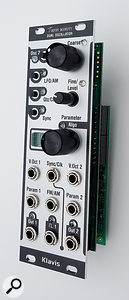The Klavis Twin Waves, also known as VCDO (Voltage Controlled Dual Oscillator) is a small, skiff-friendly module with a minimal interface. Although it boasts two separately addressable digital oscillators, only one set of controls are provided, with a button to select when they apply to Osc 2. I must admit to finding this a turn-off at first, but after a brief session with the manual I began to change my mind. This is because, unlike many modules that prioritise space-saving, the Twin Waves is actually very logical and friendly to navigate. It’s helped by a tiny but useful screen (complete with memorable icons), plus LEDs and a pass-thru mode for the controls, all of which soothe most of the problems associated with control sharing. As a further bonus, the settings are remembered over power cycles.
 Klavis Twin Waves Size: 8HP. Current: +12V = 46mA -12V = 18mA.Each oscillator can operate at audio or low frequencies and, with just a few exceptions, both are equally versatile. This is instantly apparent when you check the list of (20) available algorithms. Even though each waveform choice has just a single parameter to tweak (or externally modulate), it’s always the key parameter for that oscillator type.
Klavis Twin Waves Size: 8HP. Current: +12V = 46mA -12V = 18mA.Each oscillator can operate at audio or low frequencies and, with just a few exceptions, both are equally versatile. This is instantly apparent when you check the list of (20) available algorithms. Even though each waveform choice has just a single parameter to tweak (or externally modulate), it’s always the key parameter for that oscillator type.
Picking an algorithm is as easy as pressing the Algo encoder and whizzing through — you’re even assisted by contextual help scrolling across the screen. The oscillators include all the typical waveforms, such as a saw that morphs into a triangle and sine wave with phase modulation. Further down the list you encounter a series of multi-oscillator waves, including a quad saw with variable phase spread, a ring modulator with two built-in sine waves, oscillators with ‘self sync’ or bit-crushing, plus there’s noise, enhanced by built-in filtering. It’s a very comprehensive collection with not a turkey amongst them!
The first oscillator has a dedicated FM/AM input and also gets first dibs on the processing power. It alone can deliver additive waveforms, with control over odd, even or ‘all’ harmonic content. When switched to LFO mode, it offers knob/CV control over the modulation amplitude. In other respects the oscillators are equal. Both offer a 10-octave range, independent outputs and control, although it’s possible to configure the 1V/Oct input jacks to sum the voltages and drive the oscillators in parallel. Or, indeed, to use VCO2’s input as an offset.
Even without the manual, the parameters for each algorithm are usually obvious. They vary from PWM in the case of the square wave, the slaved oscillator frequency for a self-sync’ed oscillator and the detune spread of the five-oscillator monster that is unison saw. Incidentally, as well as the algorithms with built-in sync, regular sync is available too — in hard or soft flavours. The only limitation is the shared sync input, not that you’d typically assign both oscillators to sync duties anyway. In the Twin Waves, any incoming waveform can be a good source of sync, which isn’t always the case, and there’s a hidden Easter Egg mode offering hard or soft sync choices for the self-sync’ed waveforms too. Hold down the Sync button for a while and it appears.
When the first oscillator is acting as a VCO, the FM/AM jack offers linear Frequency Modulation and is therefore a source of wild and unruly harmonics if driven from Osc 2. Twin Waves is a ‘through-zero’ oscillator, ie. when you push it into negative frequencies, its phase is inverted. For extra kicks and giggles, you can activate the built-in pitch quantisers set up for quarter tones, major and minor scales, octaves, fifths and more. Oh, and I almost forgot: joining the regular outputs, there’s a square wave sub always available, an octave below oscillator 1.
In LFO mode the available algorithms change to new waveforms. Amongst these are various random, Brownian and vector transitions that provide far more flexibility than the average S&H implementation. While in LFO mode, the Sync socket becomes a clock input and naturally you can synchronise modulation in ratios ranging from 16 times the clock source to /64.
Firmware updates are performed by the common method of playing a WAV file and I’m told the next one (version 1.1) includes the ability to store the phase relation of stacked oscillator algorithms, plus new features for the FM/AM jack such as on-the-fly clickless algorithm selection and base note allocation for the quantiser.
Twin Waves is a whole lot of oscillator for the money and is far more capable than its modest footprint implies. It could justify its presence in any system, large or small.
£194.01
$229
